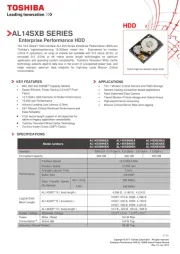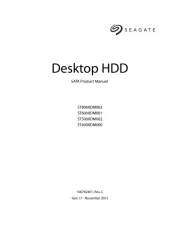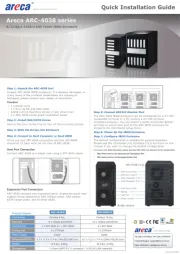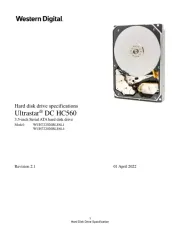Toshiba AL14SXB30EN Bedienungsanleitung
Toshiba
Festplatte
AL14SXB30EN
Lies die bedienungsanleitung für Toshiba AL14SXB30EN (11 Seiten) kostenlos online; sie gehört zur Kategorie Festplatte. Dieses Handbuch wurde von 4 Personen als hilfreich bewertet und erhielt im Schnitt 4.6 Sterne aus 2.5 Bewertungen. Hast du eine Frage zu Toshiba AL14SXB30EN oder möchtest du andere Nutzer dieses Produkts befragen? Stelle eine Frage
Seite 1/11

1 / 11
Copyright © 201 Toshiba Corporation. All rights reserved.7
Enterprise Performance HDD AL14SXB Series Product Manual
Rev. 01 Jun, : 2017
HDD
SPECIFICATIONS
Model numbers
AL14SXB90EA
AL14SXB90EE
AL14SXB90EN
AL14SXB60EA
AL14SXB60EE
AL14SXB60EN
AL14SXB30EA
AL14SXB30EE
AL14SXB30EN
Interface
SAS-3.0 (12.0 Gbit/s , 6.0 Gbit/s , 3.0 Gbit/s , 1.5 Gbit/s )
Formatted Capacity
900 GB
600 GB
300 GB
Performance
Interface Speed 12.0 Gbit/s Max
Rotation Speed 15,000 rpm
Average Latency Time
2.0ms
Buer Size
128 MiB
[5]
Data Transfer Speed
(Sustained)
4Kn / 512e
290 MiB/s
512n
2 59 MiB/s
Logical ata D
B L lock ength
AL14SXB***A ( fixed length ) 4,096 B , 4,160 B , 4,224 B
AL14SXB***E ( emulation )
HOST: 512 B, DISK: 4,096 B
HOST: 520 160 B B, DISK: 4,
HOST: 528 B B, DISK: 4,224
AL14SXB***N ( fixed length )
512 B , 520 B , 524 B , 528 B
Supply oltageV
Allowable Voltage
12 V
[6]
± 5 % / 5 V
[6]
± 5%
[7]
Power
Consumption
[8]
Write / Read
9.0 W Max
Active Idle
5.6 W Typ.
Acoustics (Sound Power)
33 dB Typ.
KEY FEATURES
• 900, 600 and 300GB
[2]
Capacity Models
• Space Efficient, Power Saving 2.5-inch
[3]
Form
Factor
• 12.0 Gbit/s SAS Interface for Better Performance
• 15,000 rpm Performance
• Industry Leading Low Latency (2.0ms)
• 24/7 Mission Critical Workload Performance and
Data Reliability
• 512n sector length support in all capacities for
optimum legacy application compatibility
•
Toshiba Persistent Write Cache Technology
• Sanitize Instant Erase (SIE
[4]
) Option
AL14SXB SERIES
HDD Enterprise Performance
The 12.0 Gbit/s
[1]
SAS interface AL14SX Series Enterprise Performance HDDs are
Toshiba’s highest-performing 15,000rpm model line. Engineered for mission
critical IT operations, an array of models are available with 512 native (512n), or
emulated 512 (512e) or 4K native sector length technologies for optimum
application and operating system compatibility. Toshiba’s Persistent Write Cache
technology protects against data loss in the event of unexpected power loss, and
helps maintain optimum data reliability for high-duty cyc
le Mission Critical
environments.
APPLICATIONS
• -Tier 1 Mission Critical Servers and RAID Storage
• Servers hosting transaction-based applications
• -Rack Optimized Data Centers
• Tiered Mission Critical storage and Hybrid Arrays-
• -High performance computing
• -Mission Critical Server Boot and Logging
Product image may represent a design model.

2 / 11
Copyright © 201 Toshiba Corporation. All rights reserved.7
Enterprise Performance HDD AL14SXB Series Product Manual
Rev. 01 Jun, : 2017
ENVIRONMENTAL LIMITS
RELIABILITY
[ 1] Read and write speed may vary depending on the host device, read and write conditions, and file size.
[2] Definition of capacity: Toshiba defines a megabyte (MB) as 1,000,000 bytes, a gigabyte (GB) as 1,000,000,000 bytes and a terabyte (TB) as 1,000,000,000,000
bytes. A computer operating system, however, reports storage capacity using powers of 2 for the definition of 1GB = 2
30
= 1,073,741,824 bytes and therefore shows
less storage capacity. Available storage capacity (including examples of various media files) will vary based on file size, formatting, settings, software and operating
system, such as Microsoft Operating System and/or pre dia content. Actual formatted capacity may vary.-installed software applications, or me
[3 - - ] "2.5 inch" and "3.5 inch" mean the form factor of HDDs or SSDs. They do not indicate drive's physical size.
[4] Sanitize Instant Erase. SIE is a function to invalidate the data recorded on the magnetic disks at a blink.
[5] A kibibyte (KiB) means 2
10
, or 1,024 bytes, a mebibyte (MiB) means 2
20
, or 1,048,576 bytes, and a gibibyte (GiB) means 2
30
, or 1,073,74 1,824 bytes.
[6] Input voltages are specified at the HDD connector side, during HDD ready state.
[7] Make sure the value is not less than 0.3V DC (less than 0.6V, 0.1ms) when turning on or off the power.- -
[8] Power supply at nominal voltage ±1%. 25°C ambient. Refer to Subsection 2.5 "Power conditions" of the SAS INTERFACE SPECIFICATION for details of idle and
ready states. "Ready state" corresponds to 2.5.2 "Active state" of the SAS INTERFACE SPECIFICATION.
[9] Vibration applied to the HDD is measured at near the mounting screw hole on the frame as much as possible.
[10] At random seek write/read and default on retry setting with log sweep vibration.
[11] At power off state after installation-
[12]MTTF (Mean Time to Failure) is not a guarantee or estimate of product life; it is a statistical value related to mean failure rates for a large number of products which
may not accurately reflect actual operation. Actual operating life of the product may be different from the MTTF.
04ACA50DA / MG04ACA50DE
Item Specication
Temperature
Operating
5 °C °C to 55
Non-O - perating 40 °C to 70 °C
Humidity
Operating
5 % to 95 % R.H. (No condensation)
Non-O perating
5 % to 95 % R.H. (No condensation)
Shock
Operating
980 m/s
2
{ } / 100 G 2 ms duration
Non-O 9 perating 3, 20 m/s
2
} / { 400 G 2 ms duration
Vibration
[9]
Operating
[10]
9.8 m/s
2
1 G } ( ) { 20 to 300 Hz or less
Non-Operating
[11]
49 m/s
2
} ( 3 ) { 5 G 20 to 00 Hz or less
Altitude
Operating
- 305 m to 3,048 m
Non-O perating
- 305 m to 12,192 m
Item Specication
MTTF
[12]
2,000,000 hours
Non-recoverable Error Rate
10 error per 10
17
bits read
Load / Unload
600,000 times
Availability
24 hours/day, 7 days/week

3 / 11
Copyright © 201 Toshiba Corporation. All rights reserved.7
Enterprise Performance HDD AL14SXB Series Product Manual
Rev. 01 Jun, : 2017
MODEL NUMBERS
Model Numbers Interface Formatted Capacity Sector Format
Optional Security
Function
AL14SXB90EA
SAS- 0 3.
900 GB
4Kn
AL14SXB90EE
SAS- 3.0
900 GB
512e
AL14SXB90EN
SAS- 3.0
900 GB
512n
AL14SXB60EA SAS- 3.0 600 GB 4Kn
AL14SXB60EE
SAS- 3.0
600 GB
512e
AL14SXB60EN
SAS- 3.0
600 GB
512n
AL14SXB30EA
SAS- 3.0
300 GB
4Kn
AL14SXB30EE
SAS- 3.0
300 GB
512e
AL14SXB30EN
SAS- 3.0
300 GB
512n
AL14SXB90EAY SAS- 3.0 900 GB 4Kn SIE
AL14SXB90ENY
SAS- 3.0
900 GB
512n
SIE
AL14SXB60EAY
SAS- 3.0
600 GB
4Kn
SIE
AL14SXB60ENY
SAS- 3.0
600 GB
512n
SIE
AL14SXB30EAY
SAS- 3.0
300 GB
4Kn
SIE
AL14SXB30ENY
SAS- 3.0
300 GB
512n
SIE
Produktspezifikationen
| Marke: | Toshiba |
| Kategorie: | Festplatte |
| Modell: | AL14SXB30EN |
| Breite: | 70.1 mm |
| Tiefe: | 100.45 mm |
| Gewicht: | 230 g |
| Höhe: | 15 mm |
| Betriebstemperatur: | 5 - 55 °C |
| Relative Luftfeuchtigkeit in Betrieb: | 5 - 95 % |
| Stromverbrauch (Standardbetrieb): | 9 W |
| Warentarifnummer (HS): | 84717050 |
| Typ: | HDD |
| Temperaturbereich bei Lagerung: | -40 - 70 °C |
| Luftfeuchtigkeit bei Lagerung: | 5 - 95 % |
| Schnittstelle: | SAS |
| Mittlere Betriebsdauer zwischen Ausfällen (MTBF): | 2000000 h |
| Komponente für: | Server/Arbeitsstation |
| HDD Kapazität: | 300 GB |
| HDD Geschwindigkeit: | 15000 RPM |
| HDD Größe: | 2.5 " |
| Höhe bei Betrieb: | -305 - 3048 m |
| Puffergröße Speicherlaufwerk: | 128 MB |
| Kontinuierliche HDD Übertragungsrate: | 259 MiB/s |
| Übertragungsrate HDD Schnittstelle: | 12 Gbit/s |
| Energieverbrauch (idle): | 5.6 W |
| Höhe bei Lagerung: | -305 - 12192 m |
| Durchschnittliche Wartezeit: | 2 ms |
| Vibrationen in Betrieb: | 1 G |
| Vibrationen außer Betrieb: | 5 G |
| Stoßfestigkeit in Betrieb: | 100 G |
| Stoßfestigkeit außer Betrieb: | 400 G |
Brauchst du Hilfe?
Wenn Sie Hilfe mit Toshiba AL14SXB30EN benötigen, stellen Sie unten eine Frage und andere Benutzer werden Ihnen antworten
Bedienungsanleitung Festplatte Toshiba

9 Juli 2025

10 Oktober 2024

28 Juli 2024

27 Juli 2024

16 Juli 2024

14 Juli 2024

13 Juli 2024

8 Juli 2024

29 Januar 2024
Bedienungsanleitung Festplatte
- PNY
- Pioneer
- Sweex
- Kingston
- Sandberg
- BLACKJET
- Sharkoon
- StarTech.com
- Hamlet
- Oyen Digital
- G-Technology
- Fantec
- Seagate
- Quark
- Fujitsu
Neueste Bedienungsanleitung für -Kategorien-

7 Juli 2025

20 Juni 2025

17 Juni 2025

16 Juni 2025

16 Juni 2025

16 Juni 2025

16 Juni 2025

16 Juni 2025


